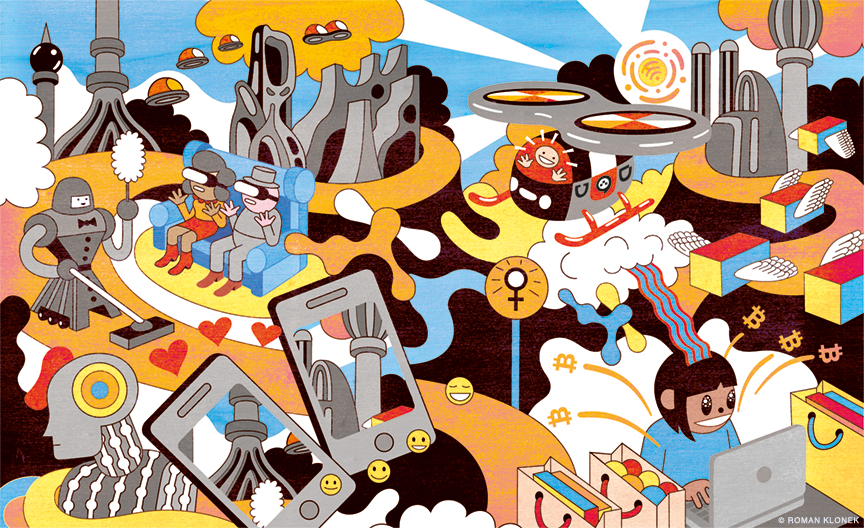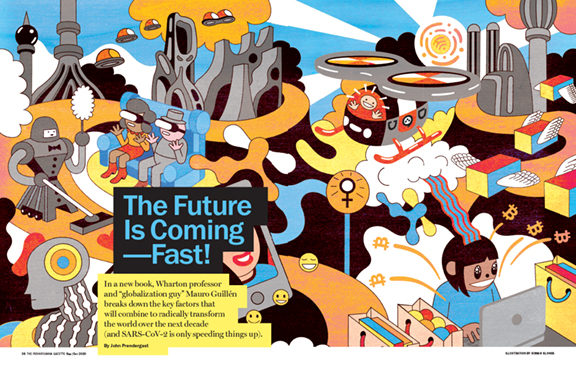
In a new book, Wharton professor and “globalization guy” Mauro Guillén breaks down the key factors that will combine to radically transform the world over the next decade (and SARS-CoV-2 is only speeding things up).
By John Prendergast | Illustration by Roman Klonek

According to Mauro Guillén, “the world as we know it is about to change, and it won’t be returning anytime soon, if ever.”
He’s not talking about the novel coronavirus.
Those words come near the end of a new book that Guillén—an expert on emerging markets who serves as the Zandman Professor of International Management at the Wharton School—finished writing back in November. Published last month, 2030: How Today’s Biggest Trends Will Collide and Reshape the Future of Everything (St. Martin’s Press) highlights how a confluence of demographic, economic, and technological developments are creating “a bewildering new reality driven by a new set of rules,” Guillén writes in the introduction. “Before we know it there will be more grandparents than grandchildren in most countries; collectively, middle-class markets in Asia will be larger than those in the United States and Europe combined; women will own more wealth than men; and we will find ourselves in the midst of more industrial robots than manufacturing workers, more computers than human brains, more sensors than human eyes, and more currencies than countries.”
Trained as a sociologist, Guillén jokes that “I am known in my little field of research as ‘Mr. Globalization Guy’—I’m the guy who studies globalization of business, big trends in the world, all of that.” He’s been writing and teaching about these issues for decades, but this outing is different, he says, pitched more toward a general audience seeking to understand the coming reality and gain insight into how to operate successfully within it. The book draws on sources ranging from academic journals to UN, WHO, and corporate reports to tech and business magazines like Wired and Fast Company to the History Channel (“Who Invented the Flush Toilet?”) and features plenty of vivid examples along with the data.
“The book was motivated by something I had been experiencing when I was making presentations about this topic, which is that people are increasingly feeling uneasy about what the world is going to look like five, 10 years down the road—because everybody realizes that things are changing very, very fast,” Guillén says.
While the book’s focus is on larger forces and longer-term developments, he’s pleased that it’s coming out now, a few months in advance of the 2020 presidential election. “We wanted to do it in the fall—because the book speaks to many of the debates for the election,” he says. Among them are “immigration, inequality, and the role of women in society, which is going to be a huge theme.”
It’s also coming out in the midst of the worst pandemic in a century. Guillén spent the locked-down half of Penn’s spring semester running a popular virtual class on the impacts of the coronavirus [“Gazetteer,” May|Jun 2020], so he thought a lot about the implications of the current crisis as 2030 moved toward publication. He’s convinced that it will—for the most part, anyway—reinforce rather than derail the trends he’s identified. “Most of the trends—from declining fertility, to intergenerational dynamics, to the use of technology—will accelerate due to the pandemic,” he writes in a brief postscript added over the summer.
Take technology adoption. “There’s no question that people who were reluctant about using technology for online shopping or for working, now they have no choice, so they’re learning,” Guillén says. Even people who “always would have preferred to go to the store” are changing out of necessity, further swelling the ranks of online shoppers. Similarly, organizations have long been wary of allowing employees to stray from the office. “Companies didn’t imagine that they could have so many remote workers,” he says. “But things are getting done remotely for at least those of us—about 32 percent of the American population—who can work from home.”
He predicts that the crisis will also speed the shift toward automation in both manufacturing and services. “The issue here is resiliency and business continuity,” in addition to the traditional allure of cost savings, he explains. “Companies have realized that during a pandemic they have to send their workers home and they have to stop doing business.” Unfortunately for affected workers, the incentives to invest in automation will go up as companies try to build resiliency into their systems. “You don’t have to send machines home because of a pandemic.” The resulting job losses will worsen economic inequality.
“I’m sticking to my guns,” he sums up. “My only regret is that instead of the title being 2030, maybe it should be 2028. I think that the future I’m describing will arrive earlier as a result.”
Guillén was born and raised in Spain, and he holds a bachelor’s degree and doctorate in political economy and business management from the Universidad de Oviedo. (He played basketball in college, and reports that his team won the championship in 1987, though adding that “I only played six minutes in the final game.”) He came to the United States for graduate school, ultimately earning master’s and PhD degrees in sociology from Yale. After that, “one thing led to the next. I decided to stay,” he says. After teaching for two years at the MIT Sloan School of Management, he came to Wharton in 1996. “I’ve been on campus longer than everyone else now, with the only possible exception of Benjamin Franklin,” he jokes.
“I am passionate about the world, its diversity, its energy, the different cultures, and the many things that we can accomplish together, or destroy if we fight,” Guillén says, of the focus of his research.
He traces the genesis of the new book back to the financial crisis of 2008. That’s when “I sensed that the world I had been born into was vanishing before my eyes,” he recalls. “So I started to assess demographic, economic, social, and technological trends to try to figure out where they were taking us. I had my ‘aha’ or ‘eureka’ moment in 2015, when I realized that the world we knew was coming to an end by 2030.”
Guillén begins the book by laying out the major demographic changes on the way. “I emphasize demographics because when it comes to thinking about pretty much every other topic—politics, the economy, businesses, industries—a lot of it depends on, who are the people? Who are the people who can be working, or who are the people who can be consumers?” he says.
Birth rates are declining all over the world, but the impact will be felt most keenly in places like Europe, Japan, and the United States, he says. Societies with aging populations and a need for workers have turned to immigration in the past, but that may be problematic given the level of antagonism towards immigrants in some quarters—which, unsurprisingly, Guillén considers “wrong and shortsighted.”
While there’s some indication that new immigrants may hold down wages for earlier ones and minorities, he writes, the weight of evidence is against claims that immigrants “steal” jobs from natives or represent a drain on social welfare systems, and in favor of immigrants as net contributors to society and the economy—whether that’s in terms of filling jobs in agriculture, construction, services, healthcare, and other areas that will be vital to serve aging populations in the West or the immigrant entrepreneurs who have founded or cofounded “44 of 87 private companies worth more than $1 billion, so called ‘unicorns.’” And rather than those extremes, job losses in developed countries have fallen much more in intermediate-skilled manufacturing jobs, and have come as the result of automation, Guillén notes. “The anxiety and anger that job losses generate should be mostly directed at technological change.”
Nevertheless, anti-immigration forces have been more effective and influential in framing their arguments, often “overpower[ing] those who have promoted its benefits,” he adds, which is important to realize as 2030 approaches. The strongest economies will “take advantage of the dynamic contributions of immigrants while at the same time taking care of those who are hurt by the constant transformation of the economy.”
Meanwhile, increased longevity everywhere will make the over-60 population the largest market segment in the world, creating opportunities for new products and services to meet the needs of an age cohort that is more tech-savvy and also less inclined—and perhaps, less able financially—to follow a clear-cut progression from work to retirement.
One growing market will be for high-tech tools to help older people preserve their independence or supplement caregiving, things like exoskeletons to help movement, virtual reality to counter isolation, and software to manage finances and keep track of important documents. In Denmark, a robotic seal (chosen because it had fewer associations than dogs or cats) is used in 80 percent of state-owned nursing homes to comfort bedridden patients.
Middle-class aspirations will be less about keeping up with the “Joneses” than with the “Singhs and the Wangs” by the next decade, Guillén suggests. “There’s a battle of the middle classes in the world going on,” he says. “It’s a battle for jobs. It’s a battle for natural resources. It’s a battle for everything—because the European and American middle class are no longer alone.”
While US and European middle classes are still richest, they are stagnant, while about 1 billion people from emerging markets will be part of the middle class by 2030. The dominance of middle classes in China, India, and elsewhere will change the nature of many things in the economy and business—for one thing, consumer products will be designed and marketed with their preferences in mind—but also in politics, he says. “It has already. A lot of middle-class people feel as if they’ve fallen behind, and they’re voting both in Europe and the United States for populist” leaders. These trends have been going on for a while but are “coming to a boiling point now.”
“Intersecting with all of that is gender,” he adds. Women’s changing goals and educational and career paths is the main factor driving the worldwide decline in birthrates, he writes. And while the book recognizes and offers examples of continuing discrimination and poverty, especially for women heading single parent households, overall women are doing much better—a trend that will advance further by 2030, Guillén says.
In the US, women earn the majority of college and graduate degrees, and are the biggest earner in 40 percent of households. “This [income] statistic must have enormous cultural implications for the future, but also saves consumer markets. That’s the other point that I made in the book.” By 2030, women’s share of wealth worldwide is estimated to be 55 percent, rising from 15 percent in 2000.
Guillén also looks at attitudes toward women leaders—changing, though too slowly—and delves into research on women’s and men’s spending habits and investment approaches, suggesting that had it been Lehman Sisters the 2008 financial crisis might have been averted.
With regard to global warming, Guillén compares the desire to find a “silver bullet” to solve the climate crisis to the focus on a vaccine against COVID-19 when “therapeutic treatments will actually be available much sooner and will probably be more effective and help us much more,” he says. “My take on climate change is that it’s a problem in cities—and about cities,” he adds. “Unless we fix cities, we’re not going to be able to address climate change.” Cities take up one percent of land, but contain 55 percent of the population and produce 80 percent of carbon emissions, he says. Most are also located along coastlines, making them more vulnerable to rising sea levels. Water shortages are another looming environmental problem in urban areas in particular.
Part of the solution involves what Guillén calls “the mundanity of excellence—it’s not a breakthrough that makes Olympic swimmers. They improve a hundred little things that in the end produce a good result,” he explains. With climate change, it will be the “mundanity of survival.” He points out that a third of food production is wasted. “And food and agriculture are the single biggest contributor to global warming.” One action cities could take is to promote vertical farming in multistory buildings to reduce food imports and avoid emissions from transportation. The added vegetation “would help absorb some of the emissions from cars and energy production facilities,” he writes.
New technologies and renewable sources of energy can help, “but behavioral change by itself can go a long way,” he says. “We could meet the goals the governments have set for carbon emission reductions, just through behavioral change.” Such changes could be produced by “nudging” people in the direction of environmentally beneficial activities, he suggests.
Noting that the average lifetime of a company listed on the S&P 500 has dropped from 60 years to 10, Guillén sees a “coming revolution in invention and innovation” comparable in technological terms to the Cambrian explosion, when approximately 541 million years ago “complex animal species appeared on land and marine ecosystems developed.”
He sketches the history of flush toilets, first invented in 1596 or so, and recent efforts to develop waterless toilets to serve the “1.5 billion people who own or share a cellphone and must relieve themselves in the open or go to a shared outhouse.” In much of Africa, where the use of mobile technology is near universal, for example, “there’s no sanitation. Or in India, for that matter,” Guillén says. In the US, we take sanitation for granted. “But once you have a city like Lagos [Nigeria, the largest city in Africa] with so many people there—most of whom have built their own house without getting a permit—how do you plan for sanitation? How do you actually build the sewer system? It’s a different kind of problem than putting cell phone towers five miles apart so that you can have cell phone service.”
From there, he touches on innovations including 3-D printing, the use of virtual reality in healthcare and for psychological treatment, artificial intelligence, and nanotechnologies. Robotics and automation will take on a broader range of tasks, he predicts, moving from manufacturing to legal services and even routine surgeries. On a future mission to Mars, 3-D printing could make it possible to create everything needed from local materials, and in the meantime could eliminate lots of well-paying blue-collar jobs back here on Earth, he writes. And nanotechnologies could upend the fashion industry and help save the environment by creating clothing able to change its properties. With real-time data collection, insurance companies could charge by individual behavior, rather than base fees on assumptions about risk groups.
“The constellation of technologies behind these potential advancements is called the ‘Internet of Things’—all of the interconnected sensors and other devices designed to run factories, mines, energy systems, transportation systems, retail facilities, vehicles, homes, offices, and even people,” Guillén writes. “By 2030, there will be about 200 billion devices and sensors connected to it.”
In a chapter called “Imagine No Possessions,” Guillén weighs the pros and cons of the so-called “sharing economy” exemplified by companies like Uber for transportation, Airbnb for housing, and TaskRabbit for any type of “gig work,” as well as many others, which have proven especially popular among millennials, with their aversion toward (or inability to make) major purchases. “In more ways than one, the sharing economy challenges fundamental assumptions and aspirations held for generations, even millennia,” Guillén writes. “What is the ‘American way of life,’ after all, if we remove the aspiration to own stuff?” And do such arrangements represent old forms of worker oppression in a new guise, as some commentators maintain, or a convenient source of supplemental income and/or a way “to avoid becoming a cubicle dweller like those depicted in the Dilbert comic strip”?
Guillén is skeptical that Bitcoin and other cryptocurrencies will ever seriously challenge governments’ control over currency. “Governments are going to fight back,” he says. “They don’t want to lose their power to print money and their authority over that.” But if the underlying concept of the blockchain [“Blockchain Fever,” Jul|Aug 2018] is broadened to “include money as one among a thousand other things that it could do for us, then I think it has a very good chance of being widely used.”
As the book’s subtitle—How Today’s Biggest Trends Will Collide, etc.—suggests, the key to understanding the world coming by 2030 is how the different developments Guillén has outlined will bounce off each other and interact. To do that requires “lateral thinking,” he says, drawing on the work of Edward de Bono, author of Six Thinking Hats.
“The basic idea is that there’s something going on over here, and you think, ‘OK, that’s interesting.’ That’s something that you may want to pay attention to, but you don’t realize that it has repercussions on so many other things that are completely unforeseeable that you didn’t really anticipate,” Guillén says. “Each little thing over here is reinforcing another over there. All of these things are feeding into this dynamic of change.”
In the book’s conclusion, he offers seven “lateral tips and tricks to survive 2030,” each flowing from the previous one. “I don’t think there is a magic formula for solving all of the problems in the world, or for individual people to adapt to all of this change—and that’s why I am in favor of a battery of recommendations as opposed to just, ‘This is the one thing that you have to do,” he says.
Guillén’s first principle, “Lose sight of the shore,” is designed to counteract the way “fear of the unknown prevents people from seizing the opportunities embedded in the massive transformations to come in 2030 and beyond.” He draws on the 16th-century story of how Spanish Conquistador Hernán Cortés scuttled the ships that had brought his 200 men from Cuba to Veracruz to prevent any attempt to return before going on to conquer the Aztec Empire. The lesson is to “overcome fear by looking ahead,” he writes—for example, by recognizing that immigrants contribute to the economy rather than steal jobs, or working to ensure that “nobody is left behind” by the technological disruptions resulting from automation and cryptocurrencies.
Lego’s rebound from declining relevance to the “Apple of Toys” is the example in “Diversify with purpose.” After a detour into branded fashion, video games, and theme parks, the company “changed course, went ‘back to the brick,’ and reengaged with diversification, this time with purpose,” he writes. “Lego realized that the formula for sustainable success was to bridge the gap between generations,” by combining the appeal of creative building with popular culture, as with The Lego Movie.
Other tips include “To be successful, start small,” which references the actual Apple, Inc. and Steve Jobs’ insight that “the best way to deal with a rapidly shifting landscape is not to plan for every move in advance but rather to be on the alert for how to improve things along the way”; “Anticipate dead ends,” a call, with caveats, for keeping your options open that acts as a kind of counterweight to tip No. 1; and “Approach uncertainty with optimism,” which counsels against letting anxiety about the future lead to a focus on avoiding losses rather than winning. “The bottom line is that the more we refocus on the opportunity rather than the downside, the greater our chances of adapting successfully,” he writes. “Climate change, for example, feels like an intractable problem, but every problem presents an opportunity for action.”
Guillén’s final principle, “Take the current,” emphasizes the importance of good timing, as he offers a litany of products that came to market too soon. Had history worked out a little differently, he notes, we might be lauding WebVan grocery home delivery, IBM’s Simon smartphone, and Microsoft’s Tablet PC as iconic advances rather than Instacart et al. and the iPhone and iPad.
But a more broadly resonant bit of advice in the present moment may be tip No. 6, “Don’t be scared of scarcity.” In the face of potential “shortages of freshwater, clean air, and hospitable land” by 2030, “perhaps we can learn a lateral trick or two from older societies that had to overcome environmental crises of their own,” Guillén writes. “Consider the Rapa Nui, better known as Easter Island.”
In his 2005 bestseller Collapse, Jared Diamond presents the story as a cautionary tale, in which territorial groups competed to build ever larger versions of the isolated island’s famous statues, cleared forests to transport them and farmed too intensively, eventually leading to “starvation, a population crash, and a descent into cannibalism.”
But Guillén cites research by other anthropologists that throw a different light on the story: there’s not much evidence that groups fought, it was mostly rats that destroyed the forest, and the islanders created carefully tended gardens to feed a growing population. They failed in the end, but not for lack of ingenuity or effort. “It is an example of collapse, there’s no question about that,” Guillén says. “Another way of looking at it is: ‘Oh my god, they survived on that tiny island for anywhere between 600 and 900 years, depending on when they arrived.’ And that’s also remarkable.”
The interesting question “is not why the collapse, but rather how come it lasted so long,” Guillén says. “And it was through cultural adaptation. They adapted. Through trial and error, they pursued other paths, they were innovative, they looked for different ways of getting organized.”
Those adaptations even included changing their religion. Few statues appear to have been built after 1500, and islanders developed an annual “ritual race for the first egg” to choose the ruling “birdman,” which Guillén calls “a rather peaceful and effective way of coping with a declining resource base.”
“For me that is the single most important thing,” he says.
The story illustrates “the lengths to which humans and human communities would go to adapt to a changing environment,” he adds. “And that I think is an optimistic message—about human resilience, and the human spirit. I don’t put it in that way in the book, but reflecting on the book in the context of this pandemic, that’s what I see. We are very good at adapting, both as individuals and as communities or groups.”




